Ultrahigh-Pressure Liquid Chromatography Analysis of Passivators and Furanic Compounds in Insulating Liquid
1,2,3-benzotriazole (BTA), tolutriazole derivative N-bis[2-ethylhexyl] aminomethyltolutriazol (TTAA), and furanic compounds in insulating oil are indicators of degradation of electrical equipment. They are periodically monitored according to standard procedures described in BS148:2009 and ASTM D5837-15. This article introduces optimization of the two separate standard methods, offering simultaneous analysis in one assay. Additional time was saved by transfer of the 30-min high performance liquid chromatography (HPLC) gradient method to a 5-min run using ultrahigh‑pressure liquid chromatography (UHPLC) conditions.
In transformers and condensers, insulating oil and paper are used to insulate conductors and cool the interior of electrical devices. Long-term operation or exposure to heat can result in degradation of these insulators, which can ultimately lead to device failure. Therefore, periodic inspection to monitor for any signs of degradation should be standard practice. Insulating paper is fixed to the device and difficult to remove, but insulating oil is easily collected and analyzed to verify device status.
1,2,3-benzotriazole (BTA) and tolutriazole derivative N-bis[2-ethylhexyl] aminomethyltolutriazol (TTAA) are additives in insulating oil, and act as passivators (metal deactivator). As they affect the risk of sulfidation, corrosion quantification of BTA and TTAA is required as specified in the British Standards (BS) BS148:2009 (1), which describes a high performance liquid chromatography (HPLC) method for this purpose. Insulating paper used as a coating for windings in transformers and condensers is made of cellulose, which decomposes at high temperatures and from contact with water or oxygen. It is then dissolved as furanic compounds in the insulating oil. Hence, the concentration of furanic compounds is an indicator of degradation of electrical equipment. ASTM D5837‑15 (2) specifies an HPLC method for this analysis. This article introduces optimization of the methods described by ASTM and BS, to offer simultaneous analysis of both passivators and furanic compounds in one assay (3). As both methods were designed for a conventional HPLC system, runtime is 30 min. By simple transfer to an ultrahigh‑pressure liquid chromatography (UHPLC) system, analysis time was reduced to about 5 min (4).
Method
Analysis of Standard Solution:Figure 1 shows the chemical structures of BTA, TTAA, and five furanic compounds. Standard solutions were prepared according to ASTM D5837-15. Furanic compounds, BTA, and TTAA were weighed individually, dissolved in acetonitrile, and then diluted with water. As there is no analytical standard TTAA commercially available, Irgamet 39 (manufactured by BASF) was used instead, as noted in BS148:2009.
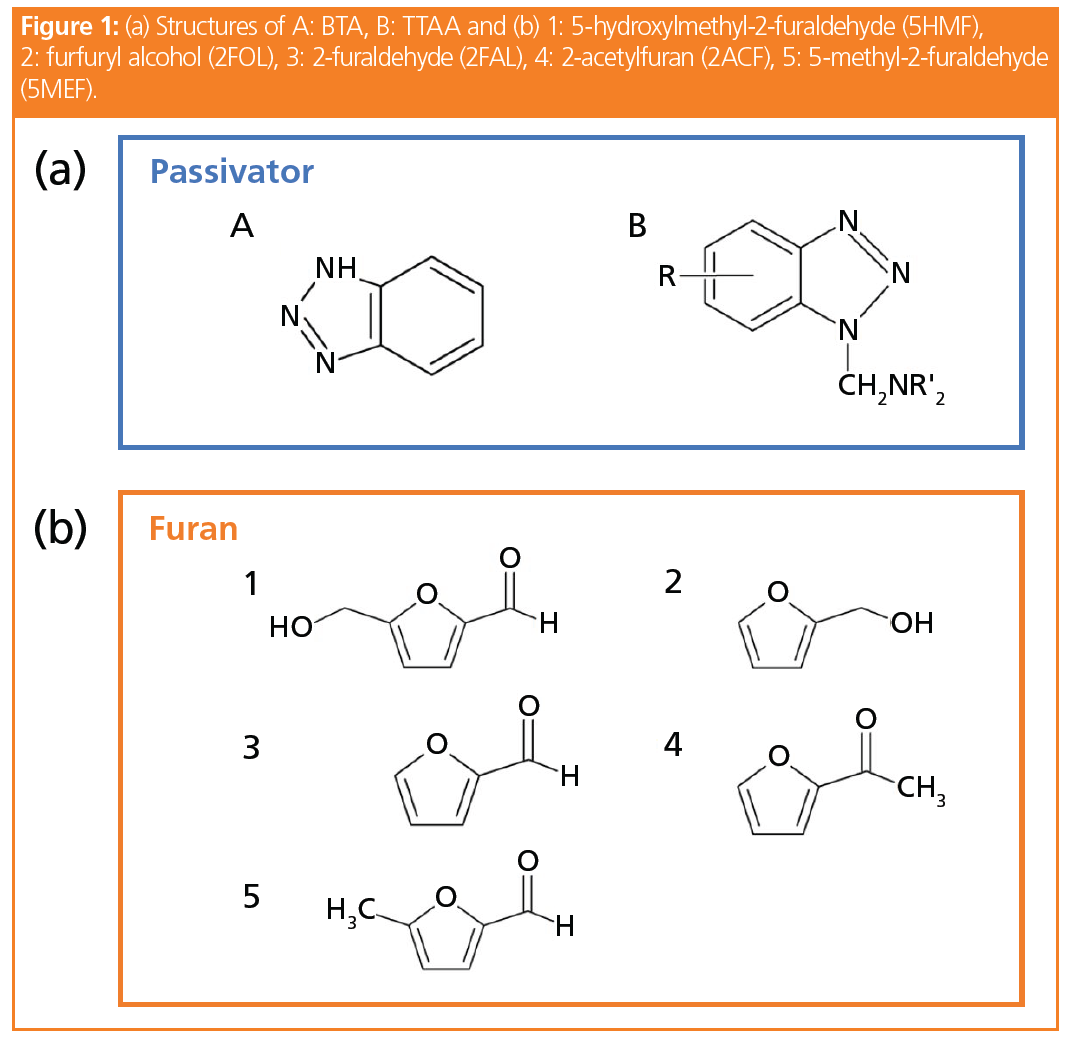
Figure 2 shows the HPLC chromatogram of the standard solution. As the Irgamet 39 is a mixture of two TTAA isomers, it eluted as two partly overlapping peaks. In this analysis, in accordance with BS148:2009, the combined value of peak areas of these two isomers was used for quantification.
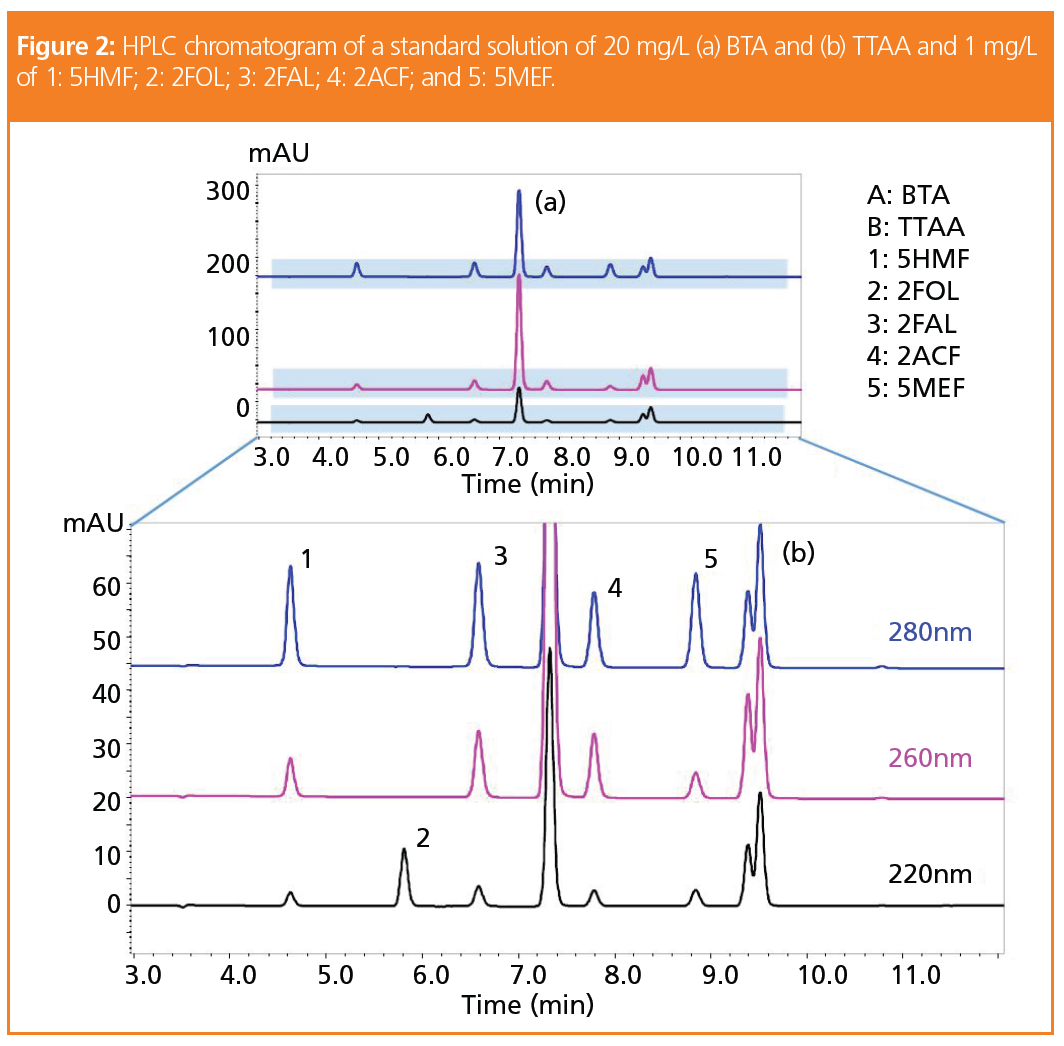
Analytical Conditions of the HPLC Analysis of BTA, TTAA, and Furanic Compounds: System: i-Series (LC-2050) (Shimadzu); column: Shim-pack VP-ODS (250 mm × 4.6 mm, 5-µm) (Shimadzu); flow rate: 1.0 mL/min; mobile phase: A) water, B) acetonitrile; time program: 15%B (0 min) " 45%B (10 min) " 100%B (20 min) " 15%B (30 min); column temperature: 40 ˚C; injection volume: 15 µL; detection (PDA): λ = 220, 260, and 280 nm.
After it was demonstrated that the passivators and furanic compounds in insulating oil can be analyzed simultaneously by optimizing the test method for furanic compounds specified in the ASTM D5837-15, further time-saving was investigated by method transfer to UHPLC conditions.
Standard chromatograms of the UHPLC analysis can be seen in Figure 3. Baseline separation of the seven compounds of interest was achieved in 1 min in a 5-min gradient run. Analytical conditions were adjusted for TTAA isomers to elute in one peak.
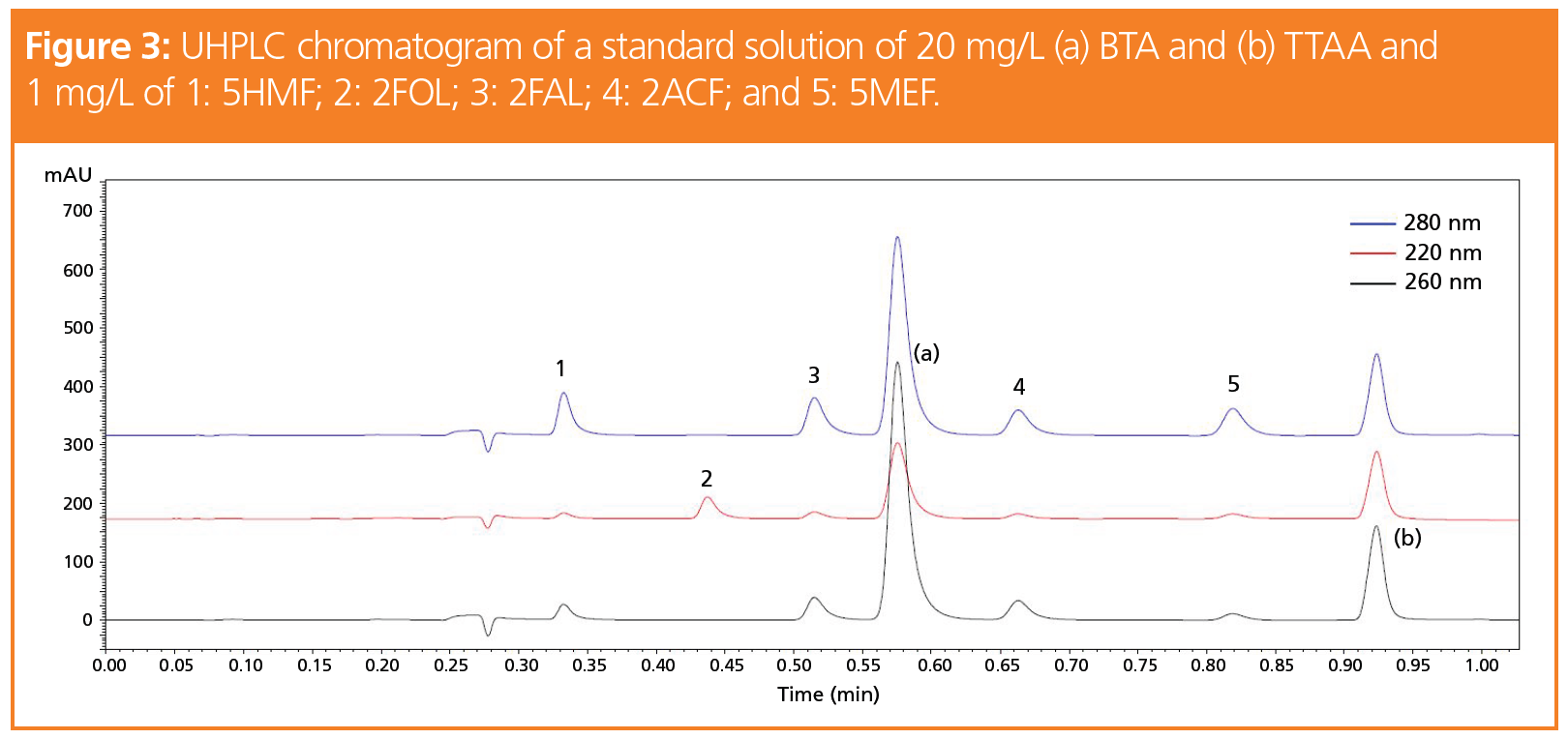
Analytical Conditions of the UHPLC Analysis of BTA, TTAA, and Furanic Compounds: System: Nexera X3 UHPLC (Shimadzu); column: Shim-pack XR-ODS III (75 mm × 2.0 mm, 1.6-µm) (Shimadzu); flow rate: 0.7 mL/min; mobile phase: A) water, B) acetonitrile; time program: 20%B (0–0.3 min) " 90%B (1 min) " 100%B (3 min) " 20%B (5 min); column temperature: 50 ˚C; injection volume: 5 µL; detection (PDA): λ = 220, 260, and 280 nm.
Results and Discussion
Linearity and Repeatability: Calibration curves were prepared from standard solutions within the concentration range of 0.2, 1, 5, 10, and 20 mg/L for BTA and TTAA, and in the range of 0.01, 0.05, 0.25, 0.50, and 1 mg/L for the furanic compounds. Repeatability was determined at the highest concentration for each analyte. With r2 > 0.9999 and %RSD ≤ 0.25% for all compounds under investigation, good linearity and repeatability was proven. Detailed results are listed in Table 1.
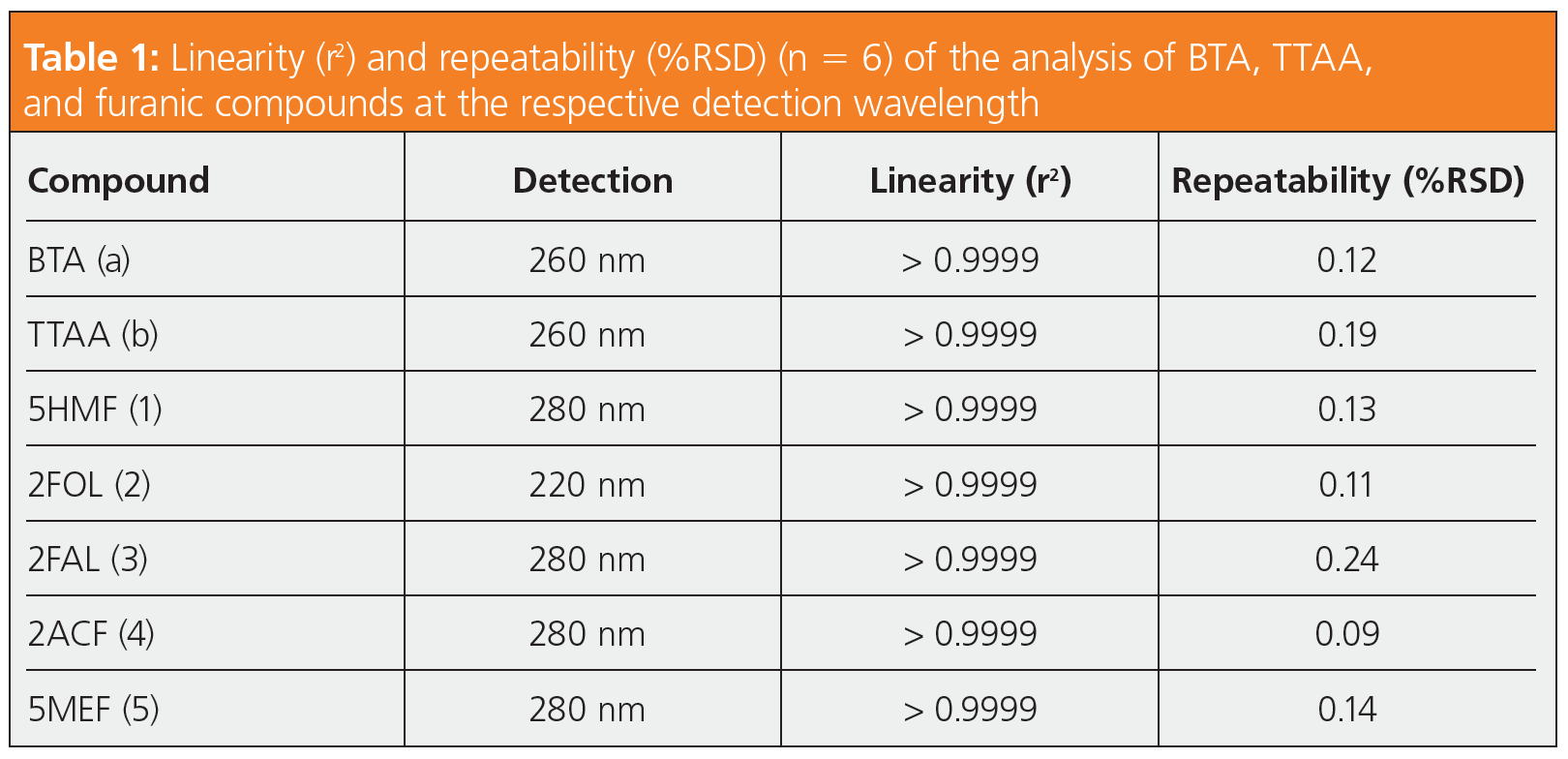
Sample Pretreatment and Determination of Recovery: All samples were pretreated following ASTM D5837‑15, as shown in Figure 4. To ensure good recovery using this method, BTA, TTAA, and furanic compound standards dissolved in toluene were spiked into white oil and extracted using the proposed protocol. The dilute supernatant was analyzed by UHPLC. As shown in Table 2, high recovery (≥ 86% for passivators and ≥ 97% for furanic compounds) and good reproducibility (%RSD ≤ 1.4) were achieved using the described pretreatment method.
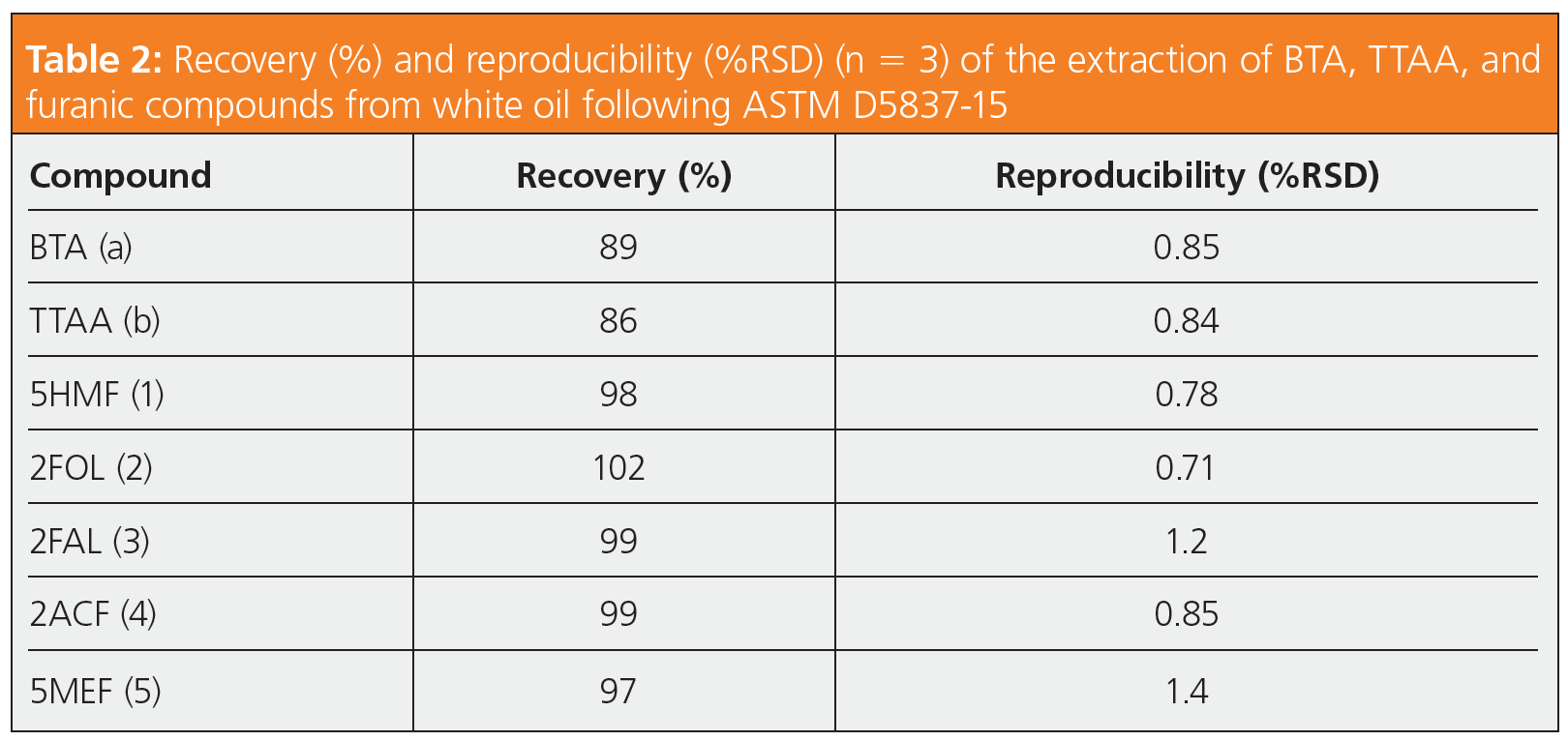

Conclusion
A fast and simple UHPLC method for simultaneous analysis of passivators and furanic compounds in insulating oil was developed by optimizing the test method for furanic compounds specified in ASTM D5837-15. Even though ASTM D5837‑15 and BS148:2009 specify separate analytical methods for quantification of BTA, TTAA, and furanic compounds, separation of the seven analytes from each other and from impurities in insulating oil could be readily achieved (1). Method transfer to UHPLC conditions led to additional time-saving. Quantification of all analytes of interest could be done in one 5-min gradient assay using the proposed conditions.
References
- British Standards Institute, BS 148:2009: Reclaimed mineral insulating oil for transformers and switchgear. Specification (Now replaced by: BS 148:2020: Recycled mineral insulating oil for transformers and switchgear. Specification), https://www.en-standard.eu/bs-148-2020-recycled-mineral-insulating-oil-for-transformers-and-switchgear-specification/
- ASTM International, ASTM D5837-15: Standard Test Method for Furanic Compounds in Electrical Insulating Liquids by High-Performance Liquid Chromatography (HPLC), https://www.astm.org/d5837-15.html
- M. Hayashida, Shimadzu Corporation Application News No. L576 (Shimadzu Corporation, November 2020).
- T. Yoshioka, Shimadzu Corporation Application News No. L587 (Shimadzu Corporation, December 2021).
Gesa Johanna Schad graduated with a diploma in chemical engineering from the Technical University NTA in Isny, Germany, in 2004, and as a master of science in pharmaceutical analysis from the University of Strathclyde in Glasgow, UK, in 2005. She worked until 2006 as a consultant in HPLC method development and validation in an analytical laboratory of the FAO/IAEA in Vienna, Austria. She gained her doctorate for research in pharmaceutical sciences at the University of Strathclyde in 2010 and was employed as an HPLC specialist in the R&D department at Hichrom Ltd in Reading, UK, from 2009. Since 2013, she has worked as a HPLC product specialist and since 2015 as HPLC Product Manager in the analytical business unit of Shimadzu Europa in Duisburg, Germany.
Takuya Yoshioka graduated with a diploma in applied biology from Osaka University in Osaka, Japan, in 2016 and a master’s degree of Eng in bioengineering from the Graduate School of Engineering, Osaka University in Osaka in 2018. He has worked as an HPLC product specialist in Shimadzu Corporation in Kyoto, Japan, since 2018.
Momoka Hayashida graduated with a diploma in biology from Ochanomizu University in Tokyo, Japan, in 2017 and a master’s degree of life sciences from Graduate School of Humanities and Sciences, Ochanomizu University in Tokyo in 2019. She has worked as an HPLC product specialist in the Solutions Center of Excellence of Shimadzu Corporation in Kyoto since 2019.
E-mail: shimadzu@shimadzu.eu
Website: www.shimadzu.eu

Investigating 3D-Printable Stationary Phases in Liquid Chromatography
May 7th 20253D printing technology has potential in chromatography, but a major challenge is developing materials with both high porosity and robust mechanical properties. Recently, scientists compared the separation performances of eight different 3D printable stationary phases.
Characterizing Polyamides Using Reversed-Phase Liquid Chromatography
May 5th 2025Polyamides can be difficult to characterize, despite their use in various aspects of everyday life. Vrije Universiteit Amsterdam researchers hoped to address this using a reversed-phase liquid chromatography (RPLC)-based approach.
New Method Explored for the Detection of CECs in Crops Irrigated with Contaminated Water
April 30th 2025This new study presents a validated QuEChERS–LC-MS/MS method for detecting eight persistent, mobile, and toxic substances in escarole, tomatoes, and tomato leaves irrigated with contaminated water.
University of Tasmania Researchers Explore Haloacetic Acid Determiniation in Water with capLC–MS
April 29th 2025Haloacetic acid detection has become important when analyzing drinking and swimming pool water. University of Tasmania researchers have begun applying capillary liquid chromatography as a means of detecting these substances.

.png&w=3840&q=75)

.png&w=3840&q=75)



.png&w=3840&q=75)



.png&w=3840&q=75)


















